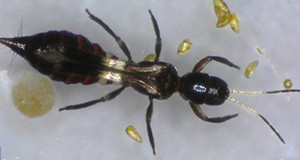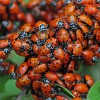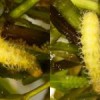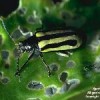
Franklinothrips vespiformis Crawford is a predatory thrips with a pantropical distribution. The distinctive red, humped-back larvae and fast-moving ant-like adults are predaceous on small arthropods. In addition to being easily mistaken for an ant, this beneficial thrips is unusual in that it constructs a silken cocoon within which it pupates. Males of this species are rare. This species is sold for use as a biological control agent in botanical gardens, zoos, interior landscapes, research greenhouses, nurseries with ornamental plants as well as outdoors in subtropical regions. This 4-page fact sheet was written by Runqian Mao, Yingfang Xiao, and Steven P. Arthurs, and published by the UF Department of Entomology and Nematology, March 2015. (Photo credit: Runqian Mao, UF/IFAS)
http://edis.ifas.ufl.edu/in1083
Tag: Beneficial Insects
Convergent Lady Beetle Hippodamia convergens Guérin-Méneville (Insecta: Coleoptera: Coccinellidae)
 The convergent lady beetle, Hippodamia convergens Guérin-Méneville, is among the most common lady beetle species throughout North America and is an important natural enemy of aphids, scales, thrips, and other soft-bodied insects. It will also feed on pollen and nectar from flowers when prey is scarce. This species can be found in habitats ranging from grasslands, forests, agricultural fields, gardens, and natural parks. It is one of the few natural enemies that are currently wild-collected from mass aggregations for distribution to the pest control industry. This 5-page fact sheet was written by Luis F. Aristizábal and Steven P. Arthurs, and published by the UF Department of Entomology and Nematology, June 2014.
The convergent lady beetle, Hippodamia convergens Guérin-Méneville, is among the most common lady beetle species throughout North America and is an important natural enemy of aphids, scales, thrips, and other soft-bodied insects. It will also feed on pollen and nectar from flowers when prey is scarce. This species can be found in habitats ranging from grasslands, forests, agricultural fields, gardens, and natural parks. It is one of the few natural enemies that are currently wild-collected from mass aggregations for distribution to the pest control industry. This 5-page fact sheet was written by Luis F. Aristizábal and Steven P. Arthurs, and published by the UF Department of Entomology and Nematology, June 2014.
http://edis.ifas.ufl.edu/in1037
Hydrilla leafcutter moth (unofficial common name) Parapoynx diminutalis Snellen (Insecta: Lepidoptera: Crambidae)
 Parapoynx diminutalis Snellen is an adventive Asian moth with an aquatic larval stage. The moth is found associated with a variety of water bodies including river backwaters, lakes, and ponds. The aquatic larvae commonly attack hydrilla and other aquatic plants. The moth was identified in 1971 in India and Pakistan during scouting trips to attempt to determine potential biological control agents for hydrilla. Despite having potential for hydrilla destruction, the moth was declared to be a generalist feeder and unsuitable for release into U.S. water bodies for hydrilla control. But the moth was later found in Florida in 1976 by United States Department of Agriculture technicians who were testing herbicides for hydrilla control. The larvae found on hydrilla were observed to be eating the invasive weed. The pathway, method, or time of the moth’s arrival remains unknown. This 5-page fact sheet was written by Julie Baniszewski, Emma N.I. Weeks, and James P. Cuda, and published by the UF Department of Entomology and Nematology, January 2014.
Parapoynx diminutalis Snellen is an adventive Asian moth with an aquatic larval stage. The moth is found associated with a variety of water bodies including river backwaters, lakes, and ponds. The aquatic larvae commonly attack hydrilla and other aquatic plants. The moth was identified in 1971 in India and Pakistan during scouting trips to attempt to determine potential biological control agents for hydrilla. Despite having potential for hydrilla destruction, the moth was declared to be a generalist feeder and unsuitable for release into U.S. water bodies for hydrilla control. But the moth was later found in Florida in 1976 by United States Department of Agriculture technicians who were testing herbicides for hydrilla control. The larvae found on hydrilla were observed to be eating the invasive weed. The pathway, method, or time of the moth’s arrival remains unknown. This 5-page fact sheet was written by Julie Baniszewski, Emma N.I. Weeks, and James P. Cuda, and published by the UF Department of Entomology and Nematology, January 2014.
http://edis.ifas.ufl.edu/in1024
Alligatorweed flea beetle Agasicles hygrophila Selman and Vogt (Coleoptera: Chrysomelidae: Halticinae) (EENY462/IN831)
 Alligatorweed is an aquatic weed native to South America that began threatening Florida’s waterways in the early 1900s. Alligatorweed flea beetles kill the plant by destroying its stored food and interfering with photosynthesis by removing leaf tissue. This insect has been an extremely effective biological control agent in coastal regions of the southeastern United States. This 3-page fact sheet was written by Ted D. Center, James P. Cuda, Michael J. Grodowitz, and published by the UF Department of Entomology and Nematology, October 2012.
Alligatorweed is an aquatic weed native to South America that began threatening Florida’s waterways in the early 1900s. Alligatorweed flea beetles kill the plant by destroying its stored food and interfering with photosynthesis by removing leaf tissue. This insect has been an extremely effective biological control agent in coastal regions of the southeastern United States. This 3-page fact sheet was written by Ted D. Center, James P. Cuda, Michael J. Grodowitz, and published by the UF Department of Entomology and Nematology, October 2012.
http://edis.ifas.ufl.edu/in831
Wasp Parasitoid Doryctobracon areolatus (Szépligeti) (Insecta: Hymenoptera: Braconidae) (EENY525/IN938)
 Doryctobracon areolatus was introduced into Florida and the Dominican Republic for control of the Caribbean fruit fly and the West Indian fruit fly. In its native habitats, parasitism of fruit flies in certain fruit can reach more than 80%. Mean parasitism of Caribbean fruit fly following original establishment in Florida was around 40%. This 4-page fact sheet was written by Charles Stuhl and John Sivinski, and published by the UF Department of Entomology and Nematology, June 2012.
Doryctobracon areolatus was introduced into Florida and the Dominican Republic for control of the Caribbean fruit fly and the West Indian fruit fly. In its native habitats, parasitism of fruit flies in certain fruit can reach more than 80%. Mean parasitism of Caribbean fruit fly following original establishment in Florida was around 40%. This 4-page fact sheet was written by Charles Stuhl and John Sivinski, and published by the UF Department of Entomology and Nematology, June 2012.
http://edis.ifas.ufl.edu/in938
Big-Eyed Bugs, Geocoris spp. (Insecta: Hemiptera: Lygaeidae) (EENY252/IN517)
 Big-eyed bugs are among those insects receiving research attention in Florida (and elsewhere) for their value as predators. To aid in identification of big-eyed bugs in Florida, a key to adults and late instar nymphs is provided in this publication. This 6-page fact sheet was written by F. W. Mead, and published by the UF Department of Entomology and Nematology, November 2011.
Big-eyed bugs are among those insects receiving research attention in Florida (and elsewhere) for their value as predators. To aid in identification of big-eyed bugs in Florida, a key to adults and late instar nymphs is provided in this publication. This 6-page fact sheet was written by F. W. Mead, and published by the UF Department of Entomology and Nematology, November 2011.
http://edis.ifas.ufl.edu/in517
Florida Predatory Stink Bug (unofficial common name), Euthyrhynchus floridanus (Linnaeus) (Insecta: Hemiptera: Pentatomidae) (EENY157/IN314)
 The predatory stink bug is considered a beneficial insect because most of its prey consists of plant-damaging bugs, beetles, and caterpillars. It seldom plays more than a minor role in the natural control of insects in Florida, but its prey includes a number of economically important species. Learn more in this 5-page fact sheet written by Frank W. Mead and David B. Richman, and published by the UF Department of Entomology and Nematology, November 2011.
The predatory stink bug is considered a beneficial insect because most of its prey consists of plant-damaging bugs, beetles, and caterpillars. It seldom plays more than a minor role in the natural control of insects in Florida, but its prey includes a number of economically important species. Learn more in this 5-page fact sheet written by Frank W. Mead and David B. Richman, and published by the UF Department of Entomology and Nematology, November 2011.
http://edis.ifas.ufl.edu/in314
Leafminer Parasitoid Opius dissitus Muesebeck (Insecta: Hymenoptera: Braconidae) (EENY501/IN902)
 Leafminers are usually the larvae of insects that feed or mine inside plant leaves, and Opius dissitus is a wasp endoparasite that keeps the population of Liriomyza leafminers in check. This 2-page fact sheet was written by Jian Li, Dakshina Seal, and Gary Leibee, and published by the UF Department of Entomology and Nematology, October 2011.
Leafminers are usually the larvae of insects that feed or mine inside plant leaves, and Opius dissitus is a wasp endoparasite that keeps the population of Liriomyza leafminers in check. This 2-page fact sheet was written by Jian Li, Dakshina Seal, and Gary Leibee, and published by the UF Department of Entomology and Nematology, October 2011.
http://edis.ifas.ufl.edu/in902
Pesticide Effects on Nontarget Organisms (PI85/PI122)
Pesticides are an integral part of agriculture as Florida's climate fosters an environment conducive to major pest outbreaks throughout the entire year. Our environment also is favorable for the development and presence of beneficial organisms that positively affect our agricultural production and enhance our wildlife and plant communities. This revised 7-page guide addresses the effects of various types of pesticides on nontarget organisms, including natural enemies and beneficial organisms, such as honeybees, wildlife, fish, and nontarget plants. Written by Frederick M. Fishel, and published by the UF Department of Agronomy, April 2011.
http://edis.ifas.ufl.edu/pi122
Parasitoids of Dipteran leafminers, Diglyphus spp. (Insecta: Hymenoptera: Eulophidae) (EENY484/IN877)
This 3-page illustrated fact sheet describes these promising biological control agents for agromyzid leafminers (Diptera: Agromyzidae) — distribution, description, hosts, and economic importance. Includes references. Written by Jian Li and Dakshina R. Seal, Published by the UF Department of Entomology and Nematology as part of the Featured Creatures Collection, December 2010.
http://edis.ifas.ufl.edu/in877
EENY462/IN831 Alligatorweed flea beetle Agasicles hygrophila Selman and Vogt (Coleoptera: Chrysomelidae: Halticinae)
EENY462, a 4-page illustrated fact sheet by Ted D. Center, James P. Cuda, and Michael J. Grodowitz, is part of the Featured Creatures collection. It describes this beetle that was the first insect ever studied for biological control of an aquatic weed — distribution, description, life cycle and biology, host, and economic importance. Includes references. Published by the UF Department of Entomology and Nematology, October 2009.
http://edis.ifas.ufl.edu/IN831
EENY424/IN803 Waterlily Leafcutter, Synclita obliteralis (Walker) (Insecta: Lepidoptera: Crambidae: Acentropinae)
EENY-424, a 4-page illustrated fact sheet by Dale H. Habeck and James P. Cuda, is part of the Featured Creatures collection. It describes this common moth that has been observed to inflict severe damage on the invasive aquatic plant Hygrophila polysperma — its distribution, description, life cycle and biology, hosts, economic importance, and related species. Includes selected references. Published by the UF Department of Entomology and Nematology, February 2009.
http://edis.ifas.ufl.edu/IN803